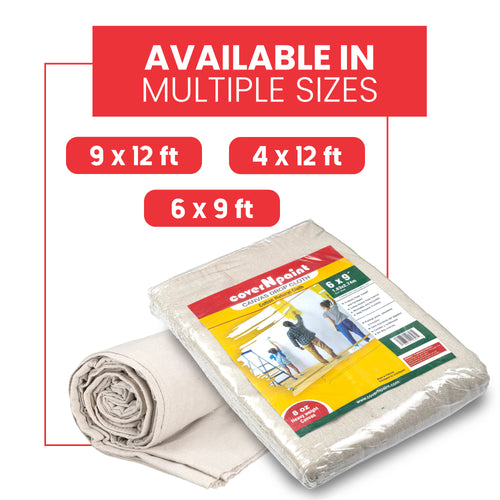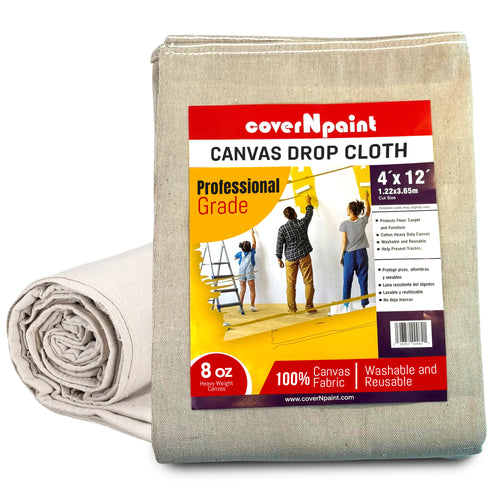During painting tasks, a Paint Drop Cloth is a protective sheet used to cover floors, furniture, and other surfaces from paint spills and splatters. It acts as a barrier to keep work spaces clean and free from damage. Drop cloths are essential for preserving the integrity of surfaces and guaranteeing a polished appearance for painting tasks. By catching paint drips and spills, they reduce the amount of time and money needed for cleanup while safeguarding furniture, carpets, and floors.
Types of Paint Drop Cloths
Canvas Drop Cloths
Because they are robust and reusable, canvas drop cloths are perfect for ongoing projects or frequent use. Because of their absorbency, paint spills can be successfully contained. Canvas drop cloths are strong and offer superior defense against paint leaks.
Drop Cloths Made of Plastic
Because they are disposable and impermeable, plastic drop cloths are ideal for easy cleanup. They provide momentary paint spill protection and are lightweight and manageable. Nevertheless, they could not absorb paint as well as canvas and can be slick.
Paper Drop Cloths
Paper drop cloths are economical and lightweight, suitable for short-term projects or one-time use. They provide basic protection against paint splatters but are less durable compared to canvas or plastic drop cloths. Paper drop cloths are best suited for indoor painting projects with minimal foot traffic.
Combination Drop Cloths
Combination drops cloths provide increased protection and adaptability by combining materials like plastic and canvas. They might have a plastic backing for waterproofing and a canvas top layer for absorption. Combination drop cloths offer a well-rounded solution by meeting the needs for both waterproofing and absorbency.
Choosing the Right Drop Cloth
Consideration of Painting Surface
Select drop cloths based on the type of surface you are painting on—hardwood floors, carpets, tiles, or concrete. Different surfaces may require specific drop cloth materials to ensure adequate protection and prevent damage.
Durability and Reusability
Consider the durability of the drop cloth in relation to the project's duration and frequency. Canvas drop cloths are durable and reusable, making them cost-effective for long-term use. Plastic and paper drop cloths are suitable for short-term projects but may need replacement after use.
Size and Coverage Area
Select drop cloths so that the entire painting area is adequately covered. Choose drop cloths that are large enough to reduce the need for readjustments while painting by measuring the size of the room or surface to be painted.
Preparing Your Workspace
Clearing the Area
Before laying down drop cloths, clear the painting area of furniture, decorations, and other obstacles. Removing obstacles ensures a clear workspace and prevents accidental paint spills or damage to items.
Securing Furniture and Fixtures
Cover or move large furniture pieces and fixtures out of the painting area to prevent paint contact. Use plastic covers or moving blankets to protect furniture from accidental drips or spills during the painting process.
Cleaning the Surface
Ensure the painting surface is clean and free of dust, dirt, and debris before laying down drop cloths. A clean surface promotes better adhesion of paint and prevents contamination that could affect the quality of the finish.
Securing the Drop Cloth
Taping Down Edges
Secure the edges of the drop cloth with painter's tape to prevent shifting or movement during the painting process. Painter's tape provides a secure hold without leaving adhesive residue on surfaces after removal.
Weighing Down with Objects
To hold the drop cloth flat and in place, arrange heavy items like furniture or paint cans along its edges or corners. The drop cloth barrier's structural integrity is preserved and unintentional displacement is avoided by using heavy objects.
Using Drop Cloth Clamps
Utilize specialized clamps or clips designed for drop cloths to secure them firmly to surfaces without causing damage. Drop cloth clamps provide a strong grip and ensure that drop cloths remain in place, even in high-traffic areas.
Covering Irregular Surfaces
Techniques for Oddly Shaped Furniture
Wrap drop cloths securely around irregularly shaped furniture or objects to ensure comprehensive protection against paint splatters and spills. Use additional tape or clamps to secure drop cloths tightly around edges and corners.
Conforming to Stairs and Ramps
Fold drop cloths strategically to cover stairs and ramps, maintaining a seamless barrier against paint spills. Ensure that drop cloths are securely anchored to prevent slippage or displacement during painting on elevated surfaces.
Wrapping Around Corners
Fold drop cloths neatly around corners and edges to prevent paint from seeping underneath and causing damage to adjacent surfaces. Tuck drop cloth material tightly against baseboards and walls to create a secure seal against paint drips.
Get Durable Drop Cloth in the USA
Regarding the availability of superior canvas drop cloths, CoverNpaint is a reputable source in the United States. With a focus on long-lasting and reusable canvas drop cloths, they provide a selection of choices to satisfy the requirements of both novice and expert painters. Their canvas drop cloths are perfect for long-term projects because they are made of sturdy fabrics that protect against paint spills and splatters.

Removing and Storing After Painting
Proper Removal Techniques
Carefully fold and remove drop cloths after completing painting projects to prevent spreading paint residues or debris. Fold drop cloths neatly to contain any paint drips or spills for disposal or cleaning.
Cleaning and Reusing
Clean reusable drop cloths according to manufacturer instructions to prolong their lifespan and effectiveness. Proper cleaning ensures that drop cloths maintain their protective qualities and are ready for future painting projects.
Folding and Storing for Future Use
Fold clean and dry drop cloths in a compact manner for easy storage in a cool, dry place. Properly stored drop cloths are readily accessible for future painting projects and maintain their protective integrity over time.
Maintaining Drop Cloths
Washing and Drying Instructions
Follow specific washing and drying instructions for different drop cloth materials to maintain their quality and effectiveness. Washing drop cloths removes paint residues and debris, ensuring they are clean and ready for reuse.
Repairing Tears or Holes
Patch or repair tears or holes in drop cloths promptly to prevent paint from leaking through during future use. Use fabric patches or adhesive materials to reinforce damaged areas and extend the lifespan of drop cloths.
Long-term Storage Tips
To stop the growth of mold or mildew, store dry, clean drop cloths in a secure place away from moisture and sunshine. Drop cloths that are stored properly are saved for the next painting operations and retain their protective properties over time.
Environmental and Safety Considerations
Disposal of Disposable Drop Cloths
Dispose of disposable drop cloths responsibly according to local waste disposal regulations. Recycling or disposing of drop cloths properly minimizes environmental impact and promotes sustainability in painting practices.
Eco-friendly Options
Choose eco-friendly drop cloth materials or reusable options to reduce environmental impact during painting projects. Eco-friendly drop cloths are made from sustainable materials and contribute to environmentally responsible painting practices.
Safety Hazards and Precautions
Take necessary safety precautions when handling paint and drop cloths to prevent slips, falls, or exposure to harmful chemicals. Wear protective clothing, gloves, and eyewear to minimize risks associated with painting and ensure personal safety throughout the process.
To sum up, applying a paint drop cloth is crucial to getting expert outcomes and safeguarding surfaces while painting. Painting may be made neat and successful if you choose the perfect drop cloth, set up your workspace efficiently, and use the right techniques for positioning and securing. Retain and store drop cloths appropriately for future use, give safety and environmental concerns a priority, and reap the rewards of economical and successful painting techniques. Have fun with your paintings!













